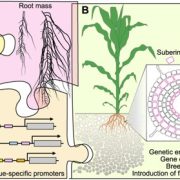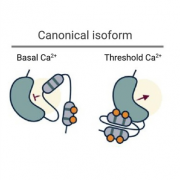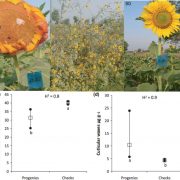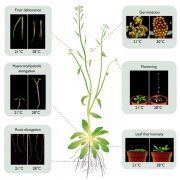COP1 regulates salt tolerance via GIGANTEA degradation in roots
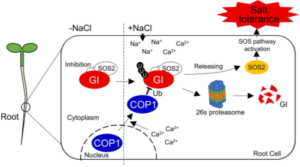 Global climate change affects weather patterns, and excess soil salinity harms plant growth. Previous studies have shown interaction between the circadian clock and salt responses. In normal conditions, the core circadian clock oscillator GIGANTEA (GI) sequesters the SOS2 kinase, part of the salt-overly sensitive (SOS) pathway. Salt stress triggers calcium signals that cause GI to break down in the cytoplasm via the 26S proteasome, activating the SOS pathway. A new study by Ji et al. reveals that these calcium signals lead to the degradation of GI exclusively in roots through the action of the E3 ubiquitin ligase COP1 protein. Under salt stress, COP1 moves to the cytoplasm where it targets GI for proteasomal destruction. COP1 has both nuclear- and cytoplasmic-localization signals, so selectively mutating these revealed that COP1 restricted to the nucleus leads to enhanced salt sensitivity, and COP1 restricted to the cytoplasm enhances salt tolerance. Furthermore, plants with mutations in both GI and COP1 show increased salt tolerance, highlighting the key role of GI. This research sheds light on the roles of COP1 and GI in salt tolerance, offering new avenues for creating salt-tolerant crops. (Summary by Yueh Cho @YuehCho1984) Plant Cell Environ 10.1111/pce.14946.
Global climate change affects weather patterns, and excess soil salinity harms plant growth. Previous studies have shown interaction between the circadian clock and salt responses. In normal conditions, the core circadian clock oscillator GIGANTEA (GI) sequesters the SOS2 kinase, part of the salt-overly sensitive (SOS) pathway. Salt stress triggers calcium signals that cause GI to break down in the cytoplasm via the 26S proteasome, activating the SOS pathway. A new study by Ji et al. reveals that these calcium signals lead to the degradation of GI exclusively in roots through the action of the E3 ubiquitin ligase COP1 protein. Under salt stress, COP1 moves to the cytoplasm where it targets GI for proteasomal destruction. COP1 has both nuclear- and cytoplasmic-localization signals, so selectively mutating these revealed that COP1 restricted to the nucleus leads to enhanced salt sensitivity, and COP1 restricted to the cytoplasm enhances salt tolerance. Furthermore, plants with mutations in both GI and COP1 show increased salt tolerance, highlighting the key role of GI. This research sheds light on the roles of COP1 and GI in salt tolerance, offering new avenues for creating salt-tolerant crops. (Summary by Yueh Cho @YuehCho1984) Plant Cell Environ 10.1111/pce.14946.


